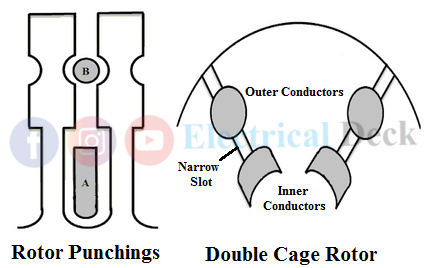Generally, the starting torque of induction motors is reasonably not high. In the case of a slip-ring induction motor, the starting torque can be increased by adding external resistance in the rotor circuit. But, we cannot obtain high starting torque in the case of a squirrel-cage induction motor.
Need For Double Cage Induction Motor :
The starting torque of an induction motor is given by,
Where R2 and X2 are the rotor resistance and inductive reactance at starting respectively, E2 is the rotor induced EMF. Here in this equation, the starting torque of the induction motor is proportional to the rotor resistance R2.
The starting torque in a squirrel cage motor is small because of its low rotor resistance and there is no way to insert external resistance as the winding is permanently short-circuited.
The starting torques of the squirrel cage motors are improved by using a double cage rotor i.e., a method of obtaining a comparatively high rotor resistance at starting (to give good starting torque) and low rotor resistance when running (to give good efficiency) in cage motors.
Construction of Double Cage Induction Motor :
The double cage rotor consists of two separate cages on the rotor. The rotor punchings on a double cage rotor are shown in the above figure.
The inner cage, bar A is made up of low resistance by increasing its cross-section area and high inductive reactance. It is deeply embedded in the rotor. The bar on the surface of the rotor shown as cage B is with a small cross-section i.e., with high resistance and low reactance values.
Working of Double Cage Induction Motor :
When the motor is connected across the supply (at starting), the frequency of the rotor induced emf or current is high which is equal to stator supply frequency. This causes more leakage flux in the inner cage conductors than that of the upper cage as shown below.
So the inductive reactance (2π f L) of the lower cage will be higher and therefore the impedance offered by the lower cage will also increase. Hence very little current flows in it. This makes most of the induced current flow through the upper cage (having high resistance and low leakage impedance). Thus motor develops high starting torque due to an increase in effective rotor resistance.
As the speed increases and becomes near to its rated speed, the frequency of the rotor-induced current decreases (less than 2 Hz). Under normal conditions, the inductive reactance and its effect on the current in the inner cage will be very small.
At this condition, most of the rotor current flows through the inner cage (since the current always tries to flow from a low resistance path). Thus the I2 R loss in the rotor circuit will not be high and therefore giving a high efficiency under running conditions.
Characteristics of Double Cage Induction Motor :
The below shows the torque-speed characteristics of the two cages separately. When s = 1 (i.e., at starting) a greater portion of torque is contributed by the outer cage. During running, the outer cage contributes only a small portion of the total torque. The double cage rotor construction of the induction motor gives excellent running characteristics under running conditions.
The high starting torque produced is confined to the upper cage due to its high resistance. So care must be taken for frequent starting of the motor with heavy loads, rather which would overheat the upper cage and its conductors and can burn.
Advantages of Double Cage Induction Motor :
- It permits high starting torque and good efficiency during running conditions.
- No need of maintaining slip rings and brushes when compared to the wound rotor.
- Since the starting current required to produce starting torque is small. The motor can be started by a direct-on-line starter.
- Useful for starting under heavy load conditions.
Comparison Between Single Cage and Double Cage Rotor :
| Single Cage Rotor | Double Cage Rotor | |
|---|---|---|
| Starting Torque | Low | High |
| Starting Current | High | Low |
| Maximum Torque | More | Low |
| Copper Loss | Low | More |
| Overall Efficiency | More | Less |
| Leakage Reactance | Low | High |
| Cost | Low | High |
| Power Factor | High | Low |
| Torque-slip Characteristics | Fixed | Wide range |
| Starter Requirement | Not suitable for DOL starting | Suitable for DOL starting (in some cases can be started without a starter). |




